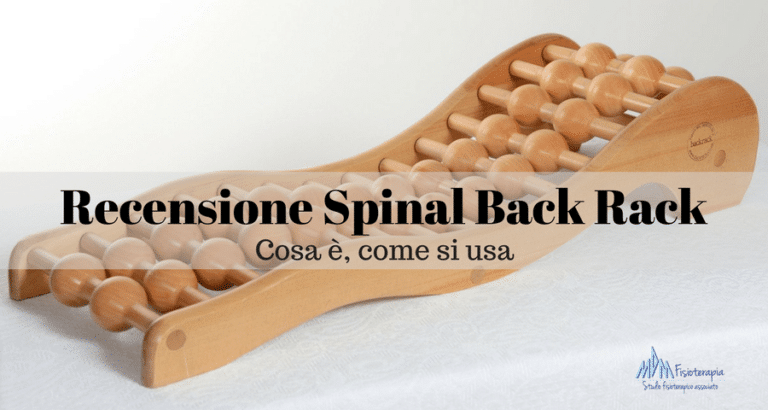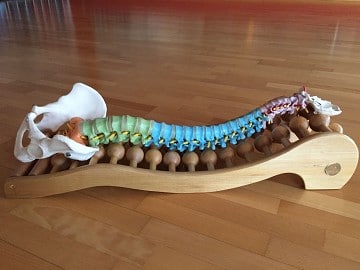Recensione Spinal Backrack

Incuriosito da una serie di video girati sulla rete circa uno strumento in legno per eseguire della ginnastica di tipo posturale ho deciso di contattare l’azienda (quale?), per provarlo e darne le mie impressioni.
Con piacere, e forse un pizzico di invidia per una gestione commerciale molto all’avanguardia, ho ricevuto nel giro di soli 2 giorni lo Spinal Backrack, direttamente al mio studio! (cosa davvero rara, con le aziende Italiane che hanno tempi biblici e paure immotivate prima di decidere di far recensire il loro prodotto).
Dentro la scatola lo strumento era già montato , assieme ad un manuale con illustrati alcuni esercizi base, e la certificazione per poterlo utilizzare nel nostro studio in totale tranquillità.
Lo Spinal Backrack è stato inventato nel 2003 da M.D Mr.Luklinski che decise di progettare lo strumento per la colonna sfruttando le sue esperienze dirette.
Come è fatto lo spinal backrack
Sostanzialmente lo strumento è composto di due fila di palline che ruotano su un asse, la cui curvatura ricorda e accompagna le curve della colonna (quindi la lordosi lombare, cifosi dorsale, e lordosi cervicale). Il materiale scelto è un legno di faggio, trattato lucido, che dona un senso di robustezza, e un aspetto Retrò, che non mi dispiace affatto.
Parliamo di 16 coppie di palline che accompagnano le curve fisiologiche dal sacro, fino al cranio con due file finali cilindriche per aiutare lo scivolamento e il posizionamento corretto del paziente una volta che si sarà steso su di essa.
Esistono 2 misure dello spinal Backrack, una small e una Large, utili per cercare di abbracciare le possibili differenze di altezze tra persone di sesso diverso ad esempio. Sarebbe pressocchè impossibile avere 32 coppie di palline (come il numero di vertebre) per le differenze anatomiche di ogni paziente.
Come si usa lo Spinal Backrack
L’utilizzo dello Spinal Backrack è davvero facile e intuitivo tanto da rendere il trattamento molto efficace proprio per la quasi totalità di pazienti a cui si può sottoporre lo strumento riabilitativo. Se pensate però che possa essere uno strumento da magari far comprare autonomamente al paziente, o prenderlo e lasciarlo li..bhe vi sbagliate di grosso! La presenza di un fisioterapita esperto che posiziona il paziente e accompagna le curve della colonna sulle curve dello spinal backrack sarà fondamentale, così come un lavoro sulla respirazione sarà imprescindibile.
La presenza di palline dure, che accompagnano la muscolatura paravertebrale è molto interessante sia per favorire un lavoro massivo sui trigger point , e sia un lavoro interessante per rilasciare e detendere la muscolatura andando indirettamente a dare sollievo alle strutture ossee sottostanti vittime spesso della contrattura muscolare, associando magari in seguito anche un trattamento strumentale come la tecarterapia ad esempio.
Il lavoro del fisioterapista nell’individuare le disfunzioni della colonna, capire le aree in cui è maggiormente necessario un intervento diretto, e una attenta valutazione posturale , analizzando quindi ogni aspetto muscolare disfunzionale, saranno la base per costruire un percorso terapeutico con lo Spinal backrack.
Cosa ci è piaciuto
Ho apprezzato molto la sua facilità di uso, e essendo un amante delle terapie miofasciali sui trigger point ho apprezzato molto il lavoro (anche se grossolano) sui muscoli, in quanto sono certo che lo strumento è in grado di dare un beneficio al paziente dopo ogni sessione.
Posizionando il soggetto ho apprezzato molto la pallina superiore che riesce ad agganciare la parte inferiore del cranio e fornire quindi un punto di ancoraggio fisso, per detendere e lavorare i muscoli suboccipitali, oltre a fungere da appoggio per favorire un allungamento della corretta lunghezza muscolare in soggetti vittime di rettilinizzazione cervicale. Stesso discorso per la colonna lombare, e in generale se impostato bene, si potrà lavorare correttamente su tutta la colonna sia in soggetti patologici, sia come prevenzione.
Un uso interessante è quello che si può fare, magari in una palestra riabilitativa acquistandone un numero adeguato, e integrando la normale ginnastica di gruppo con esercizi mirati sullo spinal Backrack.
L’attrezzo non pesa molto, e sopratutto è facilmente trasportabile a casa del paziente e sfruttabile come novità e appunto integrazione con altre terapie.
Sarà possibile acquistarlo sul sito, sia nella versione small che large
Puoi acquistare direttamente all’indirizzo:
Inoltre saranno pronti anche dei video per istruire e favorire il normale apprendimento del terapista nell’uso dello strumento, oltre a dei corsi residenziali in giro per l’Italia, che avranno il costo di 90€ + iva che verranno detratti nel caso si decida di acquistare lo strumento
Versione inglese
Intrigued by a series of videos on the Internet about a wooden device to decompress the spine and carry out a series of exercises, I decided to contact Spine Back Rack, to try it and share my impressions.
Pleasured, and perhaps envious for their very modern business management, I received within just 2 days the Spinal Backrack, straight to my office! (Something rare with Italian companies that have biblical times and unmotivated fears before deciding to have their product reviewed).
Inside the box, the device was already assembled; it had a manual with some basic exercises illustrated, and the certification to use it in our office with complete tranquillity.
Clinical consultant/Spinal specialist in Spinal Rehabilitation (Ortho.Med) Mr.Luklinski invented the Spinal Backrack in 2003, deciding to design the device for the spinal column using his direct experiences in his practice.
How the spinal Backrack works
The device is composed by two rows of balls that rotate on an axis, whose curvature recalls and accompanies the curves of the column (therefore the lumbar lordosis, dorsal kyphosis, and cervical lordosis). It is realised in beech wood, shiny-finished, which gives a sense of strength, and a retro appearance, which I like.
The Spinal Rack is about 16 pairs of balls that accompany the physiological curves from the sacrum, up to the skull, with two cylindrical final rows to help the patient slide and correctly position himself after laying on it.
The Spinal Backrack is available in 2 sizes, a small and a large, useful to try to embrace the possible differences in heights between people of different sex, for example. It would be almost impossible to have 32 pairs of balls (like the number of vertebrae) to meet the anatomical differences of each patient.
How to use the Spinal Backrack
The use of Spinal Backrack is really easy enough to make the treatment very effective for almost all patients who can undergo the rehabilitation device. However, if you think that it can be a device that can be bought independently by the patient, or take it and leave it there … then I must tell you you’re wrong! Even though the people that are buying this online are following the manual, I would recommend the presence of an expert physiotherapist/speicalist who positions the patient and accompanies the curves of the spinal column on the Backrack which is fundamental, as essential as working on the patients breathing.
The presence of hard balls, which accompany the paravertebral musculature, is very interesting both to encourage massive workings on the trigger points, and to release and detain the muscles indirectly giving relief to the underlying bone structures often subjected to muscle contraction.
The physiotherapists work in identifying the dysfunctions of the spine, understanding the areas in which a direct intervention is most needed, and a careful postural evaluation, analysing every dysfunctional muscle aspect, will be the basis to establish a therapeutic path with the Spinal Backrack.
What we liked
I really liked its ease of use and, loving myofascial therapies on the trigger points, I like the work (even if rough) on the muscles, as I am sure that the instrument can give a benefit to the patient after each session.
Positioning the patient, I really liked the upper ball that manages to hook the lower part of the skull and then provide a fixed anchorage point, to hold and work the sub-occipital muscles, as well as acting as a support to promote a lengthening of the correct muscular length in subjects suffering from cervical rectilinization. The same goes for the lumbar spine and, in general, if well set, you can work correctly on the whole column in both pathological and prevention therapies.
An interesting use is possible perhaps in a rehabilitation gym, buying a suitable number, and integrating normal group gymnastics with targeted exercises on the Spinal Backrack.
The device doesn’t weigh much (4kg) and, above all, is easily transportable to the patient’s home and exploitable as a novelty and precise integration with other therapies.
It will be possible to buy it on the website, both in the small and large versions, at a cost of:
Furthermore, some videos will be made available to instruct and encourage the normal learning of the therapist in the use of the device, in addition to residential courses all over Italy, which will cost 90€ + VAT and will be discounted if you decide to buy the device.
David Di Segni
Fisioterapista – Posturologo Specializzato nella cura del dolore cronico senza uso di Farmaci, che opera nel campo ortopedico presso studio Mdm Fisioterapia di Roma dal 2003. Iscritto all’albo con N. 2096 della sezione di Roma. Biografia completa.




